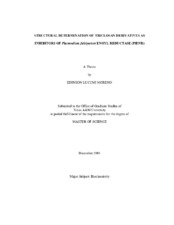| dc.contributor.advisor | Sacchettini, James C. | |
| dc.creator | Lucumi Moreno, Edinson | |
| dc.date.accessioned | 2007-04-25T20:05:39Z | |
| dc.date.available | 2007-04-25T20:05:39Z | |
| dc.date.created | 2005-12 | |
| dc.date.issued | 2007-04-25 | |
| dc.identifier.uri | https://hdl.handle.net/1969.1/4742 | |
| dc.description.abstract | Malaria is a disease that causes more than 1 million deaths per year world wide
and more than 400 million clinical cases. Due to the acquired resistance of Plasmodium
falciparum to the drugs used to control the infection, searching for new anti-malaria
drugs is necessary in modern days. Recent studies have shown that the parasite
synthesizes fatty acids using a fatty acid synthase type II (FAS-II) instead of a type-I fatty
acid synthase (FAS-I) that is present in other eukaryotes. Plasmodium falciparum enoyl
reductase (PfENR) is responsible for the last step of fatty acid biosynthesis in the
parasite. This enzyme is located within the apicoplast, a plastid-like organelle that is
responsible for several important metabolic pathways, including fatty acid biosynthesis. It
is known that triclosan is an inhibitor of ENR in bacteria and we and others have shown
that it is also effective against ENR in apicomplexan organisms such as P. falciparum.
However triclosan cannot be used to treat malaria in humans because it has metabolic
liability (glucoronidation) which limits its inhibitory potency. We have used X-ray crystallography and a Structural Activity Relationship (SAR) strategy to design and cocrystallize
a tertiary complex of PfENR with NAD+ and triclosan derivatives to improve
their properties as drugs to treat malaria. More than five hundred triclosan derivatives
were synthesized, and their in vitro and in vivo inhibitory activity evaluated. Furthermore,
structural studies were made of their affinity to interact with residues in PfENR active
sites, as well as with the cofactor NAD+. A total of six PfENR-NAD+-triclosan
analog/complexes structures were determined. Analogs which had replacements of
chloride groups at position 5 of ring A and 4' of ring B were determined, allowing the
structural analysis of the binding of these triclosan analogs to PfENR. In addition, the
urea derivatives (modification at position 1) as well as phenylsulphonamides
(modification at position 2') have shown to be more potent inhibitors than triclosan in the
in vivo assay. The analysis of the inhibitory properties and the structure of these analogs
bound to PfENR will provide novel compounds in the search for new anti-malarial drugs. | en |
| dc.format.extent | 1348866 bytes | en |
| dc.format.medium | electronic | en |
| dc.format.mimetype | application/pdf | |
| dc.language.iso | en_US | |
| dc.publisher | Texas A&M University | |
| dc.subject | triclosan | en |
| dc.subject | PfENR | en |
| dc.subject | Malaria | en |
| dc.subject | X-ray cristallography | en |
| dc.title | Structural determination of triclosan derivatives as inhibitors of Plasmodium falciparum enoyl reductase (PfENR) | en |
| dc.type | Book | en |
| dc.type | Thesis | en |
| thesis.degree.department | Biochemistry and Biophysics | en |
| thesis.degree.discipline | Biochemistry | en |
| thesis.degree.grantor | Texas A&M University | en |
| thesis.degree.name | Master of Science | en |
| thesis.degree.level | Masters | en |
| dc.contributor.committeeMember | Giedroc, David P. | |
| dc.contributor.committeeMember | Hu, James C. | |
| dc.contributor.committeeMember | Scholtz, J. Martin | |
| dc.type.genre | Electronic Thesis | en |
| dc.type.material | text | en |
| dc.format.digitalOrigin | born digital | en |


